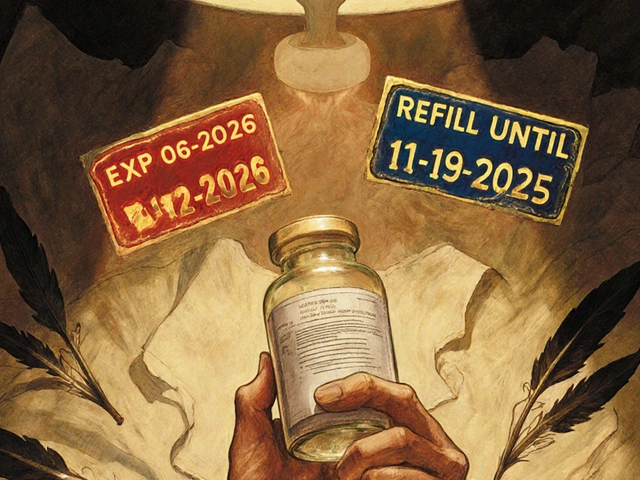If you’ve been told to try selenium for Graves’ disease, you probably want a straight answer: will it actually help? Short answer: it can, but the benefit is specific. The strongest evidence is for mild, active Graves’ orbitopathy (eye symptoms), where a 6‑month course improves comfort and slows progression. For the thyroid itself, selenium may help you reach euthyroid faster when added to antithyroid drugs, but it’s not a cure and it doesn’t replace standard treatment. Expectations matter here.
- TL;DR / Key takeaways
- Selenium has solid evidence for mild, active Graves’ orbitopathy: 200 mcg/day for 6 months (sodium selenite) improved symptoms in a large RCT and is recommended by European guidelines.
- As an add‑on to methimazole/carbimazole for hyperthyroidism, benefits are modest and mixed; it may speed symptom control in people with low selenium status, but it doesn’t prevent relapse.
- Safe range: typical supplement dose is 100-200 mcg/day for a limited time; avoid going over 400 mcg/day from all sources. Watch for hair/nail changes or “garlic” breath (toxicity signs).
- Not everyone needs a supplement. Many can meet needs with food; Brazil nuts are potent and vary wildly-easy to overshoot.
- Best fit: people with mild, active eye disease, or those likely to be low in selenium. Poor fit: already adequate intake, pregnancy at high doses, kidney disease, or long‑term high supplementation.
What selenium can (and can’t) do in Graves’ disease
Graves’ disease is an autoimmune attack on the thyroid (and sometimes the tissues behind the eyes). Selenium supports enzymes that manage oxidative stress and help convert T4 to T3, so it makes biological sense to ask if it helps. But what does the data say?
For eye symptoms (Graves’ orbitopathy), we have clear, patient‑meaningful results. A randomized, double‑blind trial in the New England Journal of Medicine (Marcocci et al., 2011) enrolled people with mild, active orbitopathy and used 200 mcg/day of sodium selenite for 6 months. Participants reported better eye comfort and quality of life, and fewer progressed to more severe disease. Benefits persisted even after stopping. On the back of that, EUGOGO (the European Group on Graves’ Orbitopathy) guideline updates in 2021 recommended this exact approach for mild, active cases, especially in regions with low selenium.
For the thyroid side (palpitations, tremor, heat intolerance from excess hormones), several small trials and meta‑analyses up to 2024 show a pattern: adding selenium to antithyroid drugs can modestly improve symptom scores and sometimes shortens time to euthyroidism. But results are inconsistent, and long‑term remission rates don’t reliably improve. The American Thyroid Association’s hyperthyroidism guideline (2016) did not endorse routine selenium for Graves’ hyperthyroidism; more recent reviews haven’t changed that stance in a big way.
So, here’s the honest framing I use when people ask me (I’m writing from Wellington, where soil selenium tends to be on the low side). If you have mild, active eye disease, selenium is a smart, evidence‑based add‑on. If you only have thyroid symptoms and you’re already on methimazole/carbimazole, selenium might help a little-especially if your diet is low-but it won’t replace your main treatment, and it won’t reliably keep Graves’ from coming back.
How to use selenium safely: doses, forms, timing, monitoring
Think of selenium as a short, targeted course-like a booster-rather than a vitamin you take forever. Here’s a simple, practical plan to follow with your clinician.
- Clarify your goal: eye symptoms, faster thyroid control, or fixing a dietary gap. Goals guide dose and duration.
- Pick the form: the landmark eye study used sodium selenite. For general supplementation, selenomethionine is common and well absorbed. Either can work; for orbitopathy, many clinicians mirror the trial with selenite.
- Set the dose and duration:
- Mild, active Graves’ orbitopathy: 200 mcg/day (as sodium selenite) for 6 months.
- Adjunct to antithyroid drugs for hyperthyroidism: 100-200 mcg/day for 3-6 months, especially if you’re likely low in selenium.
- Pregnancy: if used at all, stay in the 50-100 mcg/day supplemental range and confirm with your obstetric team (do not exceed the upper limit).
- Time it with meals: take with food to reduce nausea. You don’t need to separate it from antithyroid drugs, but a consistent routine helps adherence.
- Track results and stop if no benefit: reassess at 8-12 weeks. For orbitopathy, you should notice less grittiness, redness, and light sensitivity within the 6‑month window.
- Stay under the safety ceiling: the tolerable upper intake level is about 400 mcg/day for adults (from food plus supplements). Don’t stack multiple selenium products, and watch your Brazil nut habit.
Forms in a nutshell:
- Sodium selenite/selenate: used in the eye trial; predictable dosing; less likely to silently “store” in proteins.
- Selenomethionine: highly bioavailable; often found in multivitamins; can build up if you take high doses long‑term because it’s incorporated into proteins in place of methionine.
Monitoring tips:
- Symptoms: eye comfort, light sensitivity, tearing, and eye appearance for orbitopathy; palpitations, heat intolerance, tremor for thyroid.
- Labs: keep doing your usual thyroid labs (FT4, FT3, TSH) per your clinician-adding selenium doesn’t change that schedule.
- Selenium status testing: serum selenium or selenoprotein P exists but isn’t routinely needed; decisions are usually clinical.
- Toxicity watch: new hair brittleness or loss, nail pitting, a metallic or “garlic” breath odor, rash, or persistent nausea-stop and contact your clinician.
Two pitfalls I see often:
- Overreliance: using selenium instead of starting antithyroid medication. Don’t. Uncontrolled hyperthyroidism strains your heart and bones.
- Overshooting: stacking a 200 mcg capsule, a multivitamin, plus two Brazil nuts daily. Easy to blow past the safe limit without realizing it.

Who benefits most, and who should skip it
Best‑fit scenarios:
- Mild, active Graves’ orbitopathy (early, symptomatic eye disease): evidence‑backed, guideline‑supported.
- Likely low intake: people who rarely eat seafood, eggs, or meat; those on very restricted diets; individuals in low‑selenium regions (large parts of Europe, New Zealand, parts of China and Africa).
- As a short adjunct to antithyroid drugs when quick symptom control matters and dietary intake seems marginal.
Situations where caution or skipping makes sense:
- Already adequate intake: if you eat fish, eggs, and meat regularly, adding a high‑dose supplement may only push you toward the upper limit.
- Pregnancy: avoid high doses; discuss with your obstetrician. The aim is adequacy, not “extra.”
- Kidney disease: altered excretion can raise risk of accumulation-coordinate with your nephrologist/endocrinologist.
- Planned radioiodine with active, moderate‑severe eye disease: steroids are the proven preventive here; selenium hasn’t shown it can replace that.
- Smokers with eye disease: stopping smoking is the most impactful move for your eyes. Selenium won’t neutralize the risk of smoking‑related progression.
One practical nuance: in areas like New Zealand (where I live), soil selenium is naturally low. Many people sit near the lower end of needs, which is why a limited, supervised supplement can make sense during a Graves’ flare-especially if your diet isn’t supplying much.
Food vs supplements: practical ways to hit your target
Your body doesn’t care whether selenium came from fish or a capsule-it uses it either way. The goal is adequacy without crossing into excess.
Daily needs and safety:
- Adult needs: roughly 55-70 mcg/day (varies by sex and country guidelines; Australia/New Zealand set 60-70 mcg for most adults).
- Upper limit: ~400 mcg/day for adults (includes all sources).
Reliable food sources (typical amounts vary by soil and feed):
- Fish and shellfish (e.g., tuna, sardines, prawns): often 30-90 mcg per serving.
- Eggs: ~15-25 mcg for two eggs.
- Meat and poultry: ~15-35 mcg per serving.
- Dairy and whole grains: small to moderate amounts.
- Brazil nuts: extremely variable-one nut can have 50-300+ mcg. Treat them like a supplement, not a casual snack.
Practical rule of thumb:
- If you rarely eat seafood, eggs, or meat, consider a modest supplement (100 mcg/day) during active treatment rather than leaning on Brazil nuts.
- If you like Brazil nuts, limit to 1 nut a few days per week while you’re on a 100-200 mcg capsule, or skip nuts altogether during a 200 mcg course.
- Aim for a “Goldilocks” intake: enough to support selenoproteins, not so much that your hair and nails complain.

Checklists, evidence at a glance, FAQs, and next steps
Quick checklist for a safe, effective selenium trial:
- Do you have mild, active eye symptoms (grittiness, redness, light sensitivity)? If yes, 200 mcg/day for 6 months is a guideline‑supported option.
- Are you already taking a multivitamin with selenium? Count that toward your total.
- Any planned pregnancy, kidney issues, or other supplements to consider? Align the plan with your care team.
- Pick one product with third‑party testing; choose sodium selenite for orbitopathy to mirror the trial.
- Set a stop date (3-6 months) and a check‑in date (8-12 weeks). No open‑ended use.
Evidence snapshot and dosing detail:
| Condition/Goal | Key Study/Guideline | Population | Form & Dose | Duration | Main Outcome |
|---|---|---|---|---|---|
| Mild, active Graves’ orbitopathy | Marcocci et al., NEJM 2011; EUGOGO Guideline 2021 | Adults with mild, active eye disease | Sodium selenite 200 mcg/day | 6 months | Improved eye symptoms & QoL; fewer progressed to severe disease |
| Adjunct for hyperthyroidism control | Multiple small RCTs; meta‑analyses 2017-2024 | Adults on antithyroid drugs | Selenomethionine or selenite 100-200 mcg/day | 3-6 months | Modest symptom/lab improvements; inconsistent impact on long‑term remission |
| Hashimoto’s (for context) | ETA statement 2014; mixed RCTs | Adults with thyroiditis | Typically 200 mcg/day | 3-6 months | Not Graves’ disease; included to avoid extrapolating benefits across conditions |
| Safety ceiling | Dietary reference standards (ANZ/US/EU) | General adult population | Upper limit ≈400 mcg/day (all sources) | - | Stay below to avoid hair/nail changes, GI upset, breath odor |
Mini‑FAQ
- Will selenium fix my thyroid without meds? No. It’s an add‑on. Uncontrolled hyperthyroidism is risky; stay on guideline‑based therapy.
- How soon might I feel a difference? For eye symptoms, people often notice easing within weeks to a few months. For thyroid metrics, any benefit tends to show up over 1-3 months.
- Which form is “best”? For orbitopathy, many match the evidence and use sodium selenite. For general intake, selenomethionine is fine. The bigger picture is dose, duration, and not exceeding the limit.
- Should I test my selenium level first? It’s not routinely necessary. If you have access to testing and clear deficiency, it supports using a supplement-but clinical context rules.
- Is it safe in pregnancy? Keep total intake conservative and coordinate with your obstetric team; 50-100 mcg/day supplemental is the typical ceiling if used.
- Can it interact with methimazole/carbimazole? No meaningful drug‑drug interaction, but it can change the pace at which your thyroid normalizes-so don’t skip labs.
- What about iodine? Different story. Avoid excess iodine with Graves’ unless directed by your clinician.
Next steps and troubleshooting (pick your scenario)
- Newly diagnosed with hyperthyroidism, no eye symptoms: start standard therapy (antithyroid drugs, beta‑blocker if needed). If your diet is light on fish/eggs/meat or you live in a low‑selenium area, consider 100 mcg/day for 3 months, then reassess.
- Mild, active eye symptoms (gritty, photosensitive, puffy lids): talk to your clinician about 200 mcg/day sodium selenite for 6 months. Add lubricating drops, stop smoking, manage sleep and screen time.
- Considering radioiodine and worried about eyes: discuss steroid prophylaxis if you have eye risk factors. Selenium is not a substitute for steroids in this setting.
- Pregnant or trying: keep things simple. Focus on adequate but not high intake; if supplementing, stay 50-100 mcg/day and confirm with your obstetrician and endocrinologist.
- Vegan or restrictive diets: food sources are fewer. A short 100 mcg/day course can cover the gap during active treatment; pair with beans, whole grains, and mushrooms.
- Heavy Brazil nut snacker: pause or cap at one nut a few days per week while on a capsule. If nails turn brittle or breath smells odd, stop and get checked.
- Labs improving slowly on methimazole: ask whether a time‑limited 100-200 mcg/day addition is reasonable. Reassess labs and symptoms after 8-12 weeks; if no change, stop.
Credibility notes: The recommendations above mirror the EUGOGO 2021 guideline for eye disease, the Marcocci et al. NEJM 2011 trial for orbitopathy, and summaries from recent meta‑analyses through 2024 on selenium as an adjunct in Graves’ hyperthyroidism. The American Thyroid Association’s 2016 guideline does not recommend routine selenium for Graves’ hyperthyroidism; newer reviews remain cautious. As of 2025, nothing has overturned those core messages.
One last tip: keep the big picture in view. Good sleep, steady meals, and medication adherence often do more for day‑to‑day symptoms than any supplement. Use selenium as a precise tool, not a magic wand-and give it a clear start and stop date.
P.S. If you’re reading this from a place with low‑selenium soils (hello from Wellington), diet alone may leave you hovering near the lower end. That’s exactly when a short, well‑planned course can punch above its weight.
Key term glossary (quick refresh):
- Graves’ orbitopathy: inflammation behind the eyes causing bulging, dryness, tearing, and light sensitivity.
- Antithyroid drugs: methimazole/carbimazole and propylthiouracil-meds that slow thyroid hormone production.
- Euthyroid: normal thyroid function-your target.
- UL (upper limit): the safe daily ceiling for nutrients; for selenium, roughly 400 mcg/day from all sources.






Written by Martha Elena
I'm a pharmaceutical research writer focused on drug safety and pharmacology. I support formulary and pharmacovigilance teams with literature reviews and real‑world evidence analyses. In my off-hours, I write evidence-based articles on medication use, disease management, and dietary supplements. My goal is to turn complex research into clear, practical insights for everyday readers.
All posts: Martha Elena